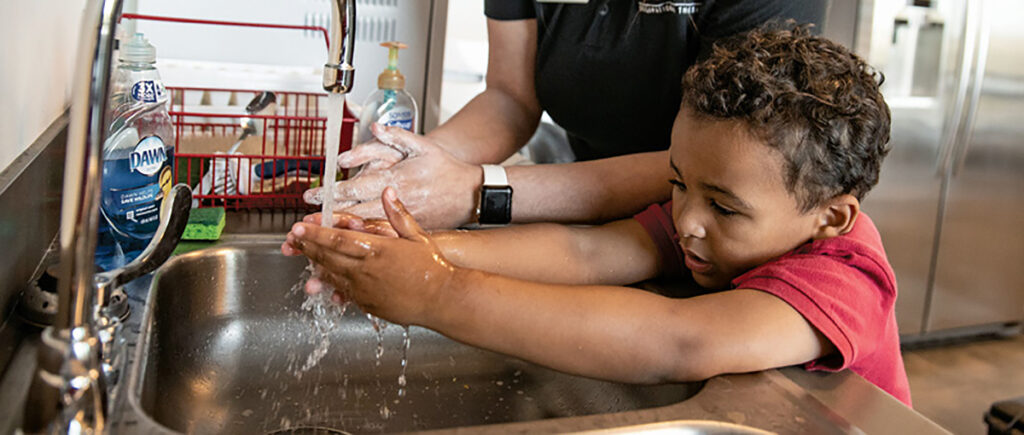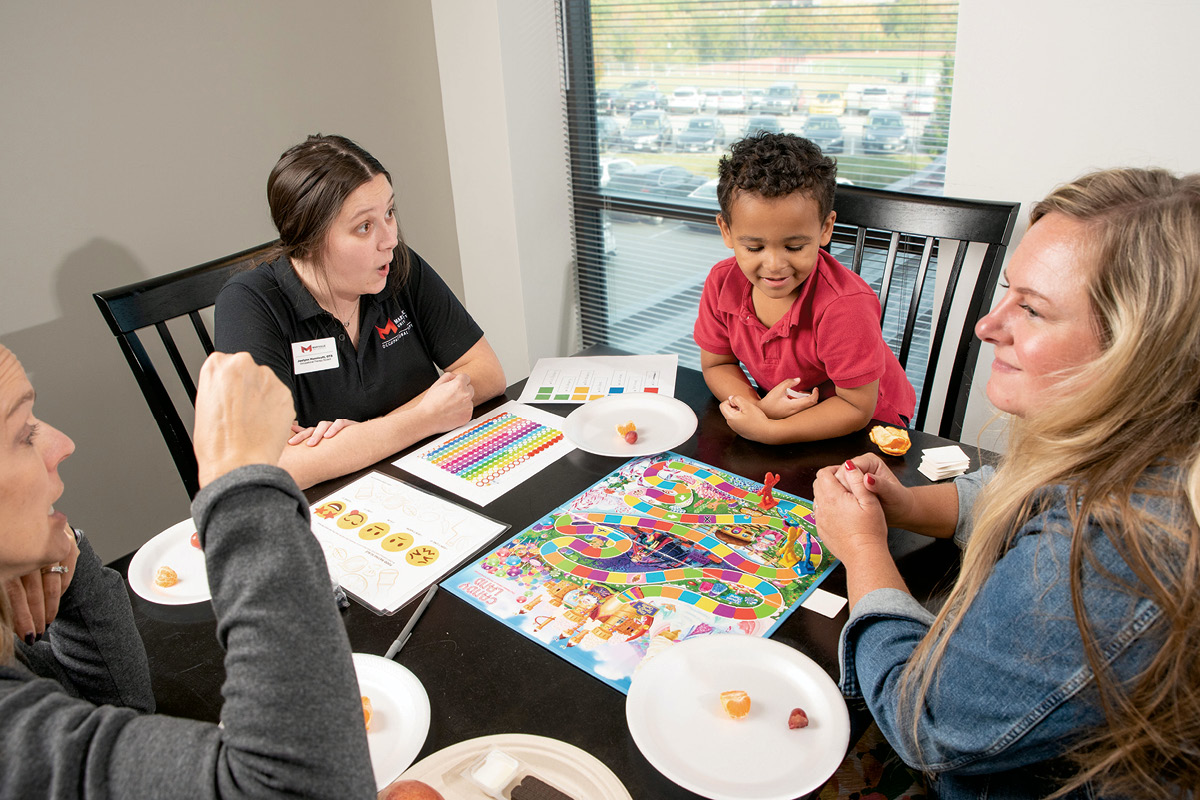The Interdisciplinary Feeding and Swallowing Team at Maryville University provides evaluation of and intervention for pediatric feeding and swallowing disorders at no cost.
A group of friends sits at a table with the colorful game Candy Land ready to play in the center. To the side, a kid-friendly fruit plate is arranged, including red grapes, clementines, blueberries, apple slices and Oreo cookie sticks and cream dip. Today, the delicious- sounding destinations and sweet adventures are a gateway to introduce new food flavors and textures to a 4-year-old boy named Aaron.
“All right, friend, what color are you going to be?” asks Sara B. Grzina, MHS, CCC-SLP, assistant professor of speech-language pathology. Aaron proudly exclaims, “Red!” before picking which colored gingerbread pawns the other friends will be. Grzina draws the first card from the pile: a single blue square that represents the challenge to bite a grape. “Do you think I can make teeth marks?” she asks Aaron. She takes a bite and shows off her handiwork. The group claps and cheers.
The next player draws a double purple card that represents the challenge to lick a cookie stick. “But first you have to smell it!” says Aaron. “I’ll do it at the same time! Let’s all do it at the same time,” he says. Leading the group, Aaron smells the cookie, touches it to his lips, licks the top and then bites a small nibble. “What do you think?” Grzina asks. “Good!” he exclaims. A few weeks ago, Aaron only ate traditional Oreos and would not even touch a cookie stick.
Today’s round of Candy Land and its creative food challenges is part of the Interdisciplinary Feeding and Swallowing Team at Maryville University. The team provides evaluation of and intervention for pediatric feeding and swallowing disorders at no cost. The program is a collaboration between Maryville’s Speech-Language Pathology and Occupational Therapy programs, two health professions that often work together across hospital-based and outpatient settings.
A pediatric feeding disorder is defined as impaired oral intake that is not age-appropriate and is associated with medical, nutritional, feeding skill and/or psychosocial dysfunction. Up to 25% of typically developing children and up to 80% of children with developmental disabilities experience feeding and swallowing disorders. Symptoms can include long mealtimes; avoidance or refusal of foods; poor weight gain; and gagging, coughing, choking or vomiting while eating.

The Maryville team leads therapy sessions in person and via telehealth, depending on the needs of each child. Sessions include interactive activities, like Candy Land and shaving cream painting, to food-based play like making pancake faces from fruit, sprinkles and chocolate chips. Like many children with swallowing and feeding disorders, Aaron, who has autism, has a limited food repertoire. He eats approximately 10 foods, including one brand of chicken nuggets and dry foods such as fruit cereal and potato chips. His sensory food aversions and texture preferences prevent him from eating fruits and vegetables and taking medicines and multivitamins.
Adults often overlook the challenges associated with certain foods, such as eating fresh blueberries. Depending on the season, they can be sweet or sour, or crunchy or soft. Another barrier is that many adults were raised to be part of the “Clean Plate Club,” which created complicated relationships with food. “When I say my son is a picky eater, a lot of people misunderstand and think it’s a choice,” said Christy White, Aaron’s mother. “But eating is a very scary thing for him. The program has been amazing because they really want him to succeed and have customized therapies just for him. They’ve created an environment that is low-risk and comfortable to take away the scariness.”
Swallowing and feeding disorders also place significant stress on the rest of the family, not just the child. Parents may cook multiple foods for a single meal, and parents and children may not eat meals together. Many parents have experienced the frustration of begging, bribing and forcing a child to eat just one bite of something. While the Maryville team focuses first on feeding and swallowing with the child, another significant part of their work is supporting and educating parents to carry over newly learned strategies into the home.
“It’s been helpful for me to observe the team interacting with Aaron, like how they redirect him when he’s off task, so I can use those tips and tricks at home,” White said. “Before the program, Aaron wouldn’t even touch foods like grapes or clementines. So, the fact that he’s now able to lick and bite these foods is wonderful. We’re really thankful.”
One goal of the Maryville team is early intervention and addressing problems during toddlerhood and early childhood. “The earlier we can intervene, the better the prognosis and the faster progress will be made,” said Michelle Scott, MOT, OTR/L, ’14, assistant professor of occupational therapy. “Feeding and swallowing impact things like attention, sleep and behavior. Eating is also a large part of our life and social interactions. It can affect how a child participates in lunch at school with friends, to their nutrition and hydration and therefore their growth and development.”

Maryville University students assist with the program during all stages, from the moment a child walks through the door to the day they graduate from therapy. Responsibilities include conducting feeding evaluations, planning therapy sessions, participating in those sessions and practicing documentation. Students from both occupational therapy and speech-language pathology are invited to participate. “It’s a unique and exciting opportunity for students because it’s unusual to receive any type of feeding and swallowing experience while in a university setting,” Grzina said. “Traditionally, students don’t get that experience until they participate in externships or fieldwork assignments. Our students are learning how to support children and families before they go out into the community, and they’re gaining real-world experiences that are preparing them for future careers.”
The feeding and swallowing experience is crucial for students who seek pediatric positions, which are highly desired and difficult to secure. “We’re hoping our program opens doors for students and gives them experience on their resume that sets them apart from other candidates,” Grzina said. Additionally, Maryville students benefit from the interprofessional collaboration modeled by faculty throughout the program. They have the opportunity to work together and learn more about each other’s disciplines, and what every health professional brings to the table, to improve the quality of care for children and families. “It’s a safe environment to practice conversations, which builds confidence for young professionals,” Grzina said, “so that they feel less intimated when they go out on their own.”
Jaelynn Hunnicutt, who is studying occupational therapy, discovered her passion for feeding and swallowing disorders after supporting her little brother. Hunnicutt has enjoyed working with Aaron because he reminds her of her brother and how feeding therapy changed his life. “Seeing Aaron’s progress in such a short time is super rewarding,” Hunnicutt said.
“I love that he’s always excited to do whatever we have planned. He always pushes himself, and some of the work we do is pretty hard work. I love watching him work through obstacles and achieve something new.”
Hunnicutt plans to pursue a career in pediatric feeding after graduation because of her experiences. She chose to attend Maryville because of the University’s Freshman Direct Entry Occupational Therapy program, which combines an undergraduate and graduate education with rigorous training in the field. “The feeding and swallowing team is an opportunity I typically wouldn’t get, and the clinical experience I’m gaining is incomparable,” she said.
